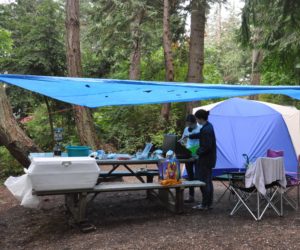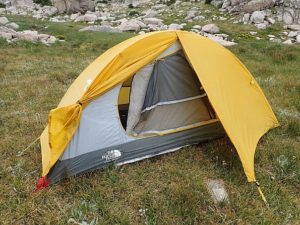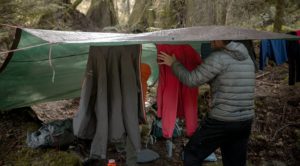Has rain ever ruined one of your camping trips because you weren’t prepared? These tips will teach you how to deal with rain for almost all camping situations. Learning about your tent setup, rain shelter, and proper rain gear will allow you to enjoy camping in all wet weather conditions.
Tent Site
Picking a good location for your tent will keep you high and dry and out of wet areas during the rain.
You want to find the high ground of your campsite. This could be on a hill or any area that is above the rest of the ground. You want to be in an area where all the water will run away from you and your tent. I like to look for natural water run-offs to help me find where to set up my tent. They can show you exactly where the high points are if you follow them uphill, as well as where the water ends up downhill of them which is a place to avoid.
Keeping away from any small valleys in the ground and away from the bottom of hills will keep you dry. These areas are where the water settles and sits which is exactly what you want to avoid.
If possible, set your tent up under or near natural shelters like trees, boulders, or shrubbery can also protect you and your tent from wet conditions. If you are under natural shelter as it rains you will limit the amount of rain that hits your tent and the surrounding area. Even being near plants will reduce the moisture in the ground as the plants will absorb a lot of the moisture from the ground.
Shelter From the rain
Setting up a shelter is crucial so you can still enjoy the outdoors while camping in the rain. By having an outdoor shelter you and your camping buddies won’t be forced to hide in your tent all trip.
A tarp and paracord string is one of my favorite methods of sheltering yourself from the rain at your campsite. This option gives you a lot of versatility when it comes to how big you want your shelter. It is very easy to set up as all you need is to tie a paracord to each corner of the tarp and then tie it up to something tall like trees, poles, or anything else you have near you. If camping in an open/flat area it may be hard to find places to hang your tarp which is a downside to this method.
A pop-up sunshade can also work great to protect you and your gear from the rain while camping. These work great in almost any situation as they are very easy to set up and work great in almost any environment.

Proper Tent Set-Up
Having the right equipment and setting it up properly is crucial when camping in wet conditions. Setting up your tent footprint and rain fly correctly will keep the inside of your tent completely dry.
Almost every tent comes with a rain fly that will fit your tent. If there is even the slightest chance of rain you should always put on the rain fly to be safe.
- First, layout the rainfly and figure out the inside and outside of it. Along with finding which side has the door opening.
- Then Properly drape it over your set up tent with the right side up and door opening aligned with the tent door.
- Next, attach the rainfly to the tent poles. All four corners of your rainfly will attach to the four corners of the stacked down the tent.
- From there you will want to tighten the rainfly. Most rainfly’s have strings on different flaps around the fly that you want to pull tight away from your tent and stake down. This gives a little space between your tent which will keep the water from hitting your tent. Along with helping the water drain off the rain fly and away from your tent.

If you don’t set up your rainfly properly it will cause many problems that can ruin a trip. Having your rainfly inside out or not opening the proper flaps and ventilation can cause the rainfly to drain the water into your tent. This shows the importance of a rainfly and paying attention when setting it up.
Having a good tent footprint or even just a tarp is a must-have when camping in the rain. This will put something between the wet ground and your tent which helps keep your tent floor dry.
Dry Out Gear and Clothes
When camping out in wet weather you are bound to get wet at some point on your trip. Properly drying out your clothes and gear while in the outdoors is essential if you plan to camp in rain. It may be hard to find a time and place to dry out clothes in the middle of a rainy day but there are different ways to dry out your stuff.
A clothesline is one of the best ways to dry out almost any wet gear or clothes that you may have during your trip. The setup is very simple and they work with almost anything that can hang on a line.
- First, find something you want to use for your clothesline. It can be set up with ease using almost any type of string or line you may have. (I prefer paracord)
- Next find two points to secure each end of the line too. This could be trees, poles, rocks, or anything tall and turd to hold up what you need to dry.
- Tie each end of the line to your secure points high enough to keep your stuff off the ground
- Hang whatever you need to dry on the line. Make sure to flip it after a while to fully dry what you need.

Another possible option is hanging your wet stuff on trees and bushes. If you don’t have a line it is great to use what you have around you. Most things in nature will also be wet after it rains but if you are able to find branches with little to no green on them, branches won’t stay wet for long. After finding the right place to hang your wet things you should hang everything you want to dry and continue to check and rotate it.
Once you find how you are going to hang your stuff to dry it is time to pick when. It is important to know what weather is coming in. This can allow you to plan a time when it’s not raining and even possibly sunny. This will be your window to hang everything you need to dry. If it is predicted to continue raining or you can’t check the weather you will need to put a tarp over your clothesline to keep them out of the rain when drying. I find it easy to set up an identical line above your clothesline where you can drape your tarp over. From there stake down all four corners to drain the water away from your clothes.
Appropriate Rain Gear
If you know you will be camping in the rain it is crucial to bring the right equipment so you can stay dry. It is very important to keep your clothes dry the best you can because once they get wet you will be uncomfortable and cold. This list will give you exactly what I like to bring on my trips with me if there is any possible chance of rain.
- Water Gaitors(help keep your pants and shoes dry walking through mud, wet grass, and more)
- Rain Jacket(keep you dry when out in the rain)
- Umbrella(keep anything under it dry)
- Quick-dry Clothes(nylon, polyester materials)
- Warm Clothes(keep you warm under your shell/rain jacket)
- Water Proof/Resistant Bags
- Plastic Zip Lock Baggies(will keep anything inside them dry)

Wrap Up
These tips and tricks will keep you dry and can make camping in the rain a blast! Anytime you go camping make sure to look at the weather for where you are going. This will allow you to know exactly what you need to plan for. My favorite and most used gear in the rain are tarps, paracord, and plastic bags.
Bring extra tarps can solve many problems you may run across in wet conditions. Tarps are so versatile and work great for sheltering you and your supplies or even using them as a tent footprint. No matter how you use them they are perfectly water-resistant as long as they are in good condition.
Paracord is a necessity for any of my camping trips but especially if I’m in the rain. They work great for hanging tarps or tensioning rain flies. They are also exactly what you need if you plan to create a clothesline. Their strength makes them great to use in almost any situation.
Lastly, I like to bring many plastic bags of all different sizes. Ziplock bags are waterproof and will protect anything inside as long as they are properly sealed. They are very cheap and can be bought at almost any store. With their versatility and accessibility, I find them a must-have when wanting to keep my gear dry in the rain.
